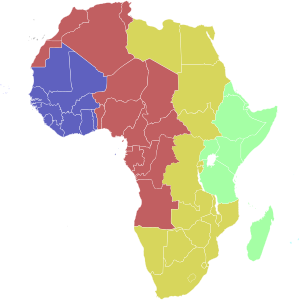Egypt Standard Time

| Light Blue | Cape Verde Time[a] (UTC−1) |
| Blue | Greenwich Mean Time (UTC) |
| Red | (UTC+1) |
| Ochre | (UTC+2) |
| Green | East Africa Time (UTC+3) |
| Turquoise | (UTC+4) |
b Mauritius and the Seychelles are to the east and north-east of Madagascar respectively.

▉▉▉ Standard time observed all year
▉ Daylight saving time observed

Egypt Standard Time (EGY) (Arabic: توقيت مصر القياسي Tawqīt Miṣr al-qiyāsiyy) is UTC+02:00, which is equivalent to Eastern European Time, Central Africa Time, South African Standard Time and Central European Summer Time, and is co-linear with neighbouring Libya and Sudan. Egypt has previously used Eastern European Summer Time (UTC+03:00), during the summer periods from 1957–2010 and 2014–15.
History
On 21 April 2011, the interim government abolished summer time. Standard time was therefore observed all year long.
On 7 May 2014, the Egyptian interim government decided to use summer time starting from 15 May 2014, the third Friday of May, with an exception for the holy month of Ramadan. This occurred just before the Egyptian presidential elections were expected to start.[1]
On 20 April 2015, The Egyptian government decided against observing summer time following a poll that had been held in April 2015 regarding applying DST or not. The government decided to make the necessary amendment to the laws and asked the ministers to work on a study to determine the probability of applying daylight saving time in coming years or not.[2] The ministry of electricity assured that the achieved electricity saving from applying summer time is not of any tangible effect.[3]
On 29 April 2016, the government under Prime Minister Sherif Ismail decided to use summer time again (UTC+03:00) by 7 July. It was to begin after Ramadan and last until the end of October. However, it was cancelled on 4 July following a vote by the Egyptian Parliament on 28 June to abolish DST, and to comply with the April 2015 presidential decree to refrain from introducing DST.
Time zone changes
| Period in use | Time offset from GMT | Name of time zone |
|---|---|---|
| Prior to 1900 | UTC+02:05:09 | Local mean time |
| 1900–1939 | UTC+02:00 | Eastern European Time |
| 15 July 1940 – 1 November 1945 | UTC+02:00 UTC+03:00 |
Eastern European Time Eastern European Summer Time |
| 1946–1957 | UTC+02:00 | Eastern European Time |
| 10 May 1957 – 19 April 2011 | UTC+02:00 UTC+03:00 |
Eastern European Time Eastern European Summer Time |
| 20 April 2011 – 15 May 2014 | UTC+02:00 | Eastern European Time |
| 16 May 2014 – 19 April 2015 | UTC+02:00 UTC+03:00 |
Eastern European Time Eastern European Summer Time |
| 20 April 2015 – present | UTC+02:00 | Eastern European Time |
IANA time zone database
The IANA time zone database contains one zone for Egypt in the file zone.tab.
| coordinates* | TZ* | Standard time | Summer time |
|---|---|---|---|
| +3003+03115 | Africa/Cairo | UTC+02:00 | not observed |
